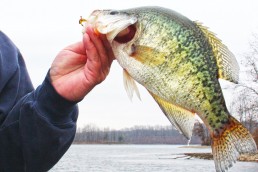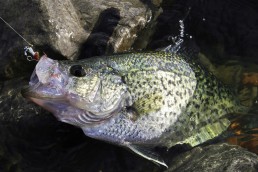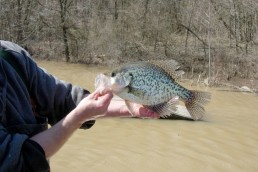Crappie, Rocks, and Boulders
SHARE THIS POST
A fisherman who grows up fishing in stained, dingy water knows that fish will typically be much shallower than in clear water. Move that same fisherman to a clear lake full of rocks and boulders, and his tactics won’t work—or at least not as well.
Clear waters, in general, have less wood cover, and require light line and a good, realistic-looking bait. Many clear, deep lakes and river-lakes have rocks and boulders that create perfect hangouts for crappies.
A lake with big rocks and boulders can provide good fishing, although searching for them can be difficult and presentations often require finesse. Casting is one way to present jigs in an efficient manner yet maintain a distance from the fish to avoid spooking them. Most fishermen agree that it’s fun to feel a “thump,” and casting provides that opportunity.
Casting a free-fall jig is efficient because bottom, cover and bites can be felt. It’s easy to focus when concentrating on only one bait and being in direct contact with it.
As with any technique, there are disadvantages when casting. The first problem is getting oriented with the cover. It may take a series of six to 12 casts to get positioned correctly to the cover. How are the fish facing? What is their exact depth? How can the rock be attacked without too many hang-ups? Casting is more than tossing a jig to a general area.
“Casting is so much different than spider rigging,” says Alex Johnson, an avid fisherman who fishes both a clear lake/river system and a stained-water river. “Your angle changes changes with current and wind. There is one bait in the water when casting, compared to multiple baits with spider rigging. However, with casting, we can test an area, catch a couple of fish and be gone, all in the same amount of time that it takes to get set up, baited and poles out with spider rigging.”
Johnson recommends paying close attention to shade. He likes to make the first presentation to the shady side of the rock. And, it’s important to make presentations from the direction that looks the most natural with the current.
“If fish are active, casting is efficient, and the crappies will usually hit immediately. If the fish are reluctant, the first thing to try is presenting the jig from different angles. We usually use a buoy to mark non-visible cover. Experience helps a fisherman know which structures are most likely to produce, but sometimes, only by fishing can you know for sure if a spot does or doesn’t have crappies.
“A lot of my scouting, finding and elimination of cover is with Side Imaging. For example, when fishing a boulder, I take a look at Side Imaging, Down Imaging and sonar, all from different angles, to see if crappies are present. Down Imaging really helps pinpoint things.”
Johnson says he likes to pick spots with lots of fish when fishing for fun. However, tournaments are different, because instead of looking for spots loaded with fish, he wants to find rocks with only three or four fish on them, because they are more likely to be better quality crappies. This is especially true on the river.
“It’s difficult passing spots with lots of fish in search of bigger fish, like we do during tournaments. The exception to the rule is when the bite is tough; then the odds are better by fishing larger schools.”
Are you enjoying this post?
You can be among the first to get the latest info on where to go, what to use and how to use it!
Presentation
The ideal setup begins with electronics to pinpoint a spot. A marker buoy makes casting easier by providing a reference to the cover, rock or boulders. Boat position is based upon the wind and current. Johnson stated he would rather have a 10 mph wind than a shifting 5 mph wind. A shifting wind makes maintaining boat control more difficult. If a fisherman has one of the trolling motors with a Spot Lock feature, staying positioned isn’t difficult.
Line type and size can be a controversial issue, but the key is to keep your line small in diameter. Monofilament and co-filament lines are very soft, manageable and allow good casting distance. Fluorocarbons are a little stiffer but are tough and more sensitive due to less stretch. Johnson has switched to 8-pound-test braid because it has such as small diameter and is limp. The key is the no-stretch line because it is super-sensitive, allowing him to better feel the bottom, cover and distinguish bites. Presentations are more productive because of feel.
He also believes in Quick-Set weedless jigheads in 1/16-ounce, because he can get them in more places without getting hung up. A hang-up often ends the fishing in a spot.
Jig colors vary from fisherman to fisherman and lake to lake. Rocky, clear water lakes and rivers are places to try muted and natural colors like soft-pink and white, light blue-white, clear sparkle and pumpkinseed. It doesn’t mean that black-chartreuse won’t be the best color, but the muted colors have a good history in clear water.
Fine tune
A big boulder or group of rocks can provide cover for crappies. Even after the fish are found, it’s important to make a good presentation. A fisherman must be able to feel the bottom, rocks and secondary cover. To do this, cast past the cover, let the jig drop to the desired depth and bring it back. Pay close attention to what the jig is doing. After catching a fish or two, the depth, angle of retrieve, speed and action can be repeated.
Think natural. When possible, cast from downstream or from the sides of a boulder. A bait moving with the current looks more natural than one being pulled upstream.
Become a MidWest Outdoors Insider here!
MWO
SHARE THIS POST
Did you enjoy this post?
You can be among the first to get the latest info on where to go, what to use and how to use it!
Tim Huffman
Tim Huffman specializes in crappie fishing, is editor for two crappie magazines, as well as writing for several others. In 2018, he published his sixth book, Limiting Out for Crappie, available at Amazon. His first article appeared in MidWest Outdoors in 1988.



